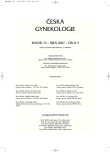Current Condition of Diagnosis and Therapy of Overactive Urinary Bladder in Czech Republic
Současný stav diagnostiky a léčby hyperaktivního měchýře v České republice
Úvod:
Pojem hyperaktivní měchýř (overactive bladder - OAB) označuje komplex symptomů urgencí s nebo bez urgentní inkontinence, zpravidla provázených frekvencemi a nykturiemi. Hyperaktivní měchýř patří k nejčastějším zdravotním problémům naší populace s významným dopadem na kvalitu života. Cílem práce je zhodnotit pomocí dotazníkového šetření současné povědomí o tomto problému mezi gynekology a urology České republiky.
Materiál a metody:
Byly hodnoceny odpovědi celkem 290 respondentů, z toho 181 gynekologů a 109 urologů. Z celkového počtu gynekologů jich 104 (57,5 %) pracuje v ambulantní praxi, 21 (11,6 %) v lůžkovém zařízení a 56 (30,9 %) v obou typech zdravotnického zařízení současně. Z 109 urologů jich celkem 31 (28,4 %) pracuje v ambulantní praxi, l5 (13,8 %) pracuje v lůžkovém zařízení a 63 (57,8 %) současně v obou typech zařízení. Dotazy obsažené v dotazníku byly cíleny zejména na oblast definice, diagnostiky a terapie OAB. Výsledky byly zpracovány metodami deskriptivní statistiky, použité metodologické instrumentárium bylo anonymní.
Výsledky:
Respondující gynekologové se během jednoho týdne setkají průměrně s 5,54 pacienty trpícími OAB, respondující urologové se setkávají týdně průměrně s 12,64 pacientů trpících OAB.
Správnou definici OAB uvedlo pouze 9 respondentů (3,1 %). Alespoň 3 základní symptomy (urgence, frekvence, urgentní inkontinence) uvedlo ve svých odpovědích celkem 57 (19,6 %) respondentů. V diagnostice OAB je nejvíce využívána anamnéza (280 respondentů/96,5 %), vyšetření moči (255/87,9 %), lokální urogynekologické vyšetření (247/85,2 %), urodynamické vyšetření (UDV) (183/63,1 %), validované dotazníky (174/60 %), mikční deníky (139/47,9 %), uroflowmetrie (UFM) (138/47,6 %) a cystoskopie (134/46,2 %). V léčbě je nejčastěji první volbou podání anticholinergik, následovano mikčním tréningem a lokální estrogenní terapií.
Závěr:
Obecné povědomí o problematice OAB je mezi odbornou veřejností stále ještě nízké. V diagnostických i terapeutických postupech lze najít významné rozdíly mezi gynekology a urology. Je žádoucí větší počet center, které by se problematikou OAB komplexně zabývaly.
Klíčová slova:
hyperaktivní měchýř, deskriptivní statistika, diagnostika, terapie, farmakoterapie
Authors:
J. Krhut 1; M. Gärtner 2
Authors‘ workplace:
Urologické oddělení FN Ostrava - Poruba
1; Gynekologicko-porodnická klinika FN Ostrava-Poruba
2
Published in:
Ceska Gynekol 2007; 72(5): 360-365
Category:
Original Article
Overview
Introduction:
The concept of overactive bladder (OAB), indicates complex symptoms of urgency, with or without urgent incontinence and it is generally accompained by urinary frequency and nocturia. Overactive urinary bladder belongs to one of the most common health problem in our population with significant impact on quality of life. The aim of this study is to assess this problem simultaneously between gynecologists and urologists in Czech Republic, by forwarding questionnaire.
Material and methods:
There were 290 respondants who answered this assessment. Out of this total number, 181 were gynecologists, and 109 urologists. Of this total number, 104 gynecologists (57.5%) work in out-patient clinic, 21 of them (11.6%) in hospital, and 56 (30.9%) in both this departments. 31 of urologists (28.4%) work in out-patient clinic, 15 of them (13.8%) in hospital, and 63 (57.8%) in both this departments.
Inquiry and questions included in questionnaire were espescially aimed at definition, diagnosis, and therapy of OAB. Results were worked by method of descriptive statistics, used instrumental method was anonym.
Results:
Respondant gynecologists in the course of a week meet approx. 5.54 patients who suffering OAB, and respondant urologists meet in a week approx. 12.46 patients who suffering OAB. Correct definition of OAB mentioned only by 9 respondants (3.1%). At any rate, 57 respondants (19.6%) mentioned the basic symptoms i.e. urgency, urinary frequency, and urgent incontinence in their answer. Most common parameters employed for diagnosis of OAB including pt. history (280 respond. 96.5%), urine examination (255/87.5%), local urogynecological examination (247/85.2%), urodynamic investigation (183/63.1%), validated questionnaire (174/60%), voiding diary (139/47.9%), uroflowmetry (138/47.6%), and cystoscopy (134/46.2%). Most frequent therapeutic option is anticholinergic, followed by urinary bladder training, and application of local estrogen.
Conclusion:
Common knowledge about OAB problem is still low among experts and specialists. Diagnostic and therapeutic approach of OAB is significantly different between gynecology and urology. It is somehow advisable to have many centers in where the problem of OAB can be completely engaged and solved.
Key words:
overactive bladder, descriptive statistics, diagnostic, therapy, pharmacotherapy
Labels
Paediatric gynaecology Gynaecology and obstetrics Reproduction medicineArticle was published in
Czech Gynaecology

2007 Issue 5
Most read in this issue
- Inherited Metabolic Disorders and Pregnancy
- Da Vinci Robotic Surgery in Gynaecological Oncology: a Critical Interim Appraisal
- Basal-like Carcinoma of the Breast – the Actual Review and Clinico-Pathological Corelations
- Progression and Regression Low Grade Intraepitelial Squamous Lesions in Context of Positivity of High Risk Human Papillomavirus
